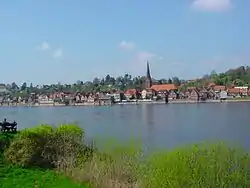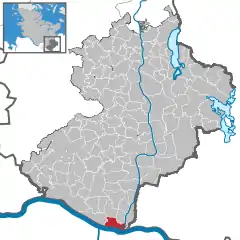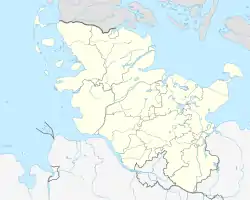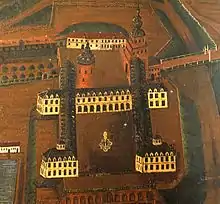Lauenburg
Lauenburg (German pronunciation: [ˈlaʊ̯ənˌbʊʁk] ⓘ), or Lauenburg an der Elbe (English: Lauenberg on the Elbe), is a town in the state of Schleswig-Holstein, Germany. It is situated on the northern bank of the river Elbe, east of Hamburg. It is the southernmost town of Schleswig-Holstein and belongs to the Kreis (district) of Herzogtum Lauenburg.
Lauenburg | |
|---|---|
 View from the Elbe | |
 Flag  Coat of arms | |
Location of Lauenburg within Lauenburg district  | |
 Lauenburg  Lauenburg | |
| Coordinates: 53°23′N 10°34′E | |
| Country | Germany |
| State | Schleswig-Holstein |
| District | Lauenburg |
| Government | |
| • Mayor | Andreas Thiede |
| Area | |
| • Total | 9.54 km2 (3.68 sq mi) |
| Elevation | 49 m (161 ft) |
| Population (2021-12-31)[1] | |
| • Total | 11,644 |
| • Density | 1,200/km2 (3,200/sq mi) |
| Time zone | UTC+01:00 (CET) |
| • Summer (DST) | UTC+02:00 (CEST) |
| Postal codes | 21481 |
| Dialling codes | 04153 |
| Vehicle registration | RZ |
| Website | www |
History
The town was founded in 1182 by Bernard of Ascania, the ancestor of the Dukes of Lauenburg. It took its name from that of the castle of Lowenborch (erected here between 1181 and 1182), deriving from Lave, the Polabian-language name of the Elbe (compare modern Czech Labe).

Saxe-Lauenburg was a duchy until 1 July 1876, when it was incorporated into the Royal Prussian Province of Schleswig-Holstein. Lauenburg served as the ducal capital until 1616, when the castle burnt down. In 1619 the capital was moved to Ratzeburg. The area of the duchy was roughly identical with that of today's district. In medieval times Lauenburg was a waypoint on the Old Salt Route, while today it is the southern terminus of the Elbe-Lübeck Canal.
Following the Napoleonic Wars, Lauenburg was ceded by Prussia to Denmark in exchange for the region of Pomerania.
Between 1945 and 1982 Lauenburg served as West German inner German border crossing for cars travelling along Bundesstraße 5 between the Soviet Zone of occupation in Germany (till 1949), thereafter the East German Democratic Republic, or West Berlin and the British zone of occupation (till 1949) and thereafter the West German Federal Republic of Germany. The traffic was subject to the Interzonal traffic regulations, that between West Germany and West Berlin followed the special regulations of the Transit Agreement (1972).
Culture and sights
Lauenburg has many historic buildings from the 17th century and earlier. These include houses, which were mostly the homes of sailors, and the Maria-Magdalenen Church, which was built in the 13th century.
The town is nestled at the bottom of 50 meter high bluffs. Narrow streets up the hill lead to the "upper town" where Lauenburg Castle is located. Lauenburg Castle used to be the residence of the Dukes of Lauenburg and the political centre of the Dukedom. Over the century most parts were destroyed and replaced by modern buildings, but the old castle tower remains. Presently, the castles serve as city and municipal administration. From the castle, one can see the river Elbe, the town of Lauenburg, and the flat marshland of Lower-Saxony on the southern shore of the Elbe, which used to belong to the duchy until it was ceded to the then neighbouring Kingdom of Hanover in 1814. On a clear day it is possible to see as far as Lüneburg, about 25 km (16 mi) southwest of Lauenburg.
Lauenburg also has the "Palmschleuse", a historic river lock, originally built in 1398 and renewed in the 17th century. It is the oldest of its kind in Europe.
Notable residents
- Bernard II, Duke of Saxe-Lauenburg (1385/1392–1463), ruler
- Eric I, Duke of Saxe-Lauenburg-Ratzeburg (c. 1280–1360), ruler
- Eric II, Duke of Saxe-Lauenburg-Ratzeburg (1318/20–1368), ruler
- Eric IV, Duke of Saxe-Lauenburg (1354–1411), ruler
- Eric V, Duke of Saxe-Lauenburg (died 1436), ruler
- Mathilde Block (1850–1932), painter, embroiderer
- Karl Ludwig Harding (1765–1834), astronomer
- John V, Duke of Saxe-Lauenburg (1439–1507), ruler, reconstructed Lauenburg Castle
- Jürgen Plagemann (born 1936), rower, won Olympic silver in 1964
International relations
Lauenburg is twinned with:
 Boizenburg (Germany)
Boizenburg (Germany) Dudelange (Luxembourg)
Dudelange (Luxembourg) Lębork (Poland) (formerly Lauenburg in Pommern)
Lębork (Poland) (formerly Lauenburg in Pommern) Manom (France)
Manom (France)
References
External links
- Official website
 (in German)
(in German) - Altstadt-Lauenburg (in German)